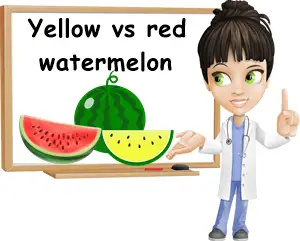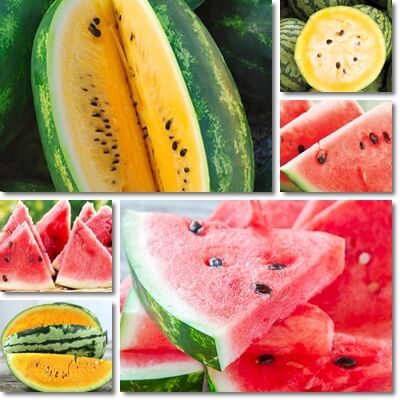Watermelons, yellow and red, are essentially different versions of the same fruit. The biggest difference between yellow watermelon and red watermelon is the flesh color.
Yellow watermelon is yellow inside because it contains more yellow-pigmented antioxidants called xanthophylls, vs red watermelon which is red inside because it contains more orange and red-pigmented antioxidants such as lycopene
Differences in flesh color
Yellow watermelon and red watermelon are the exact same fruit, just different varieties of it, hence their different flesh color.
The reason why yellow watermelon is yellow inside is because it is high in yellow-pigmented chemicals known as xanthophylls and, at the same time, lower in orange and red-pigmented chemicals.

Versus yellow, the reason why red watermelon is red inside because it is high in orange and red-pigmented chemicals, predominantly the red carotenoid lycopene, but also beta-carotene, alpha-carotene and gamma-carotene, among others. At the same time, red watermelon is lower in yellow pigments which further contributes to the dominance of the red pigments in flesh color.
Depending on the exact ratio of each pigment, various shades of yellow and red are possible, from pale yellow to canary yellow in yellow watermelon to several shades of medium to dark pink, pink-red, red and orange-red in red watermelon.
Differences in antioxidants profile
How do you tell if a watermelon is yellow or red? Unless you know beforehand, you can’t really tell from the outside if a watermelon is yellow or red inside. The difference in flesh color is owed to varying levels of pigmented chemicals, primarily antioxidants. Yellow watermelon is high in xanthophylls, yellow-colored carotene antioxidants.
Existing research shows yellow watermelon is highest in neoxanthin followed by violaxanthin, neochrome, luteoxanthin, lutein, all yellow pigments (source). Some research also identifies beta-carotene as one of the main pigments in some yellow watermelon varieties (source).
By comparison, red watermelon is highest in lycopene. Lycopene is a bright red carotenoid antioxidant and the major pigment in red watermelon. Also responsible for red watermelon color are beta-carotene and, to a lesser extent, alpha-carotene, gamma-carotene, zeta-carotene and other red and orange pigments.
By comparison, in orange watermelon varieties the flesh color is a result of a high content of beta-carotene paired with a low content of red lycopene and yellow xanthophylls. Orange watermelon is the best source of beta-carotene of all watermelon colors.

Different taste and flavor profile
Yellow watermelon definitely does not taste exactly the same as red watermelon and the differences in taste and flavor profile between yellow and red-fleshed watermelons can be traced back to factors such as variety, growing conditions, fruit maturity and ripeness.
But what color watermelon is the sweetest between yellow and red? For the most part yellow watermelon tends to be sweeter and more flavorful than red. Yellow watermelon has a stronger and more straightforward sweet taste with deep honey and sweet fruity flavors vs red watermelon which is also quite sweet and fruity, but in a different way, lighter and fresher. If you have good taste perception, you will likely notice the differences in taste from the very first bite.
Differences in sugar content
There are over 1000 different watermelon varieties, including yellow and red, so, chances are, the sugar content will vary between them.
Factors such as variety, growing conditions, degree of fruit ripeness at harvest time and more impact end sugar content in the fruit.
This being said, a perfectly ripe yellow watermelon generally tends to be sweeter than red because of its slightly higher sugar content.
At the same time, according to Purdue University, sugar content in most orange and yellow-fleshed watermelon varieties studied by them was in the similar range as the sugar content in red-fleshed varieties (source).
So, depending on your experience with yellow and red watermelons, you may find either statement is true.
Different flesh texture
Both yellow and red watermelon are extremely juicy, with soft, crisp, sweet flesh. But yellow watermelon is denser and somewhat softer, although still crisp, while red watermelon is less dense, crunchier and also a bit stringy, with short strands of flesh sometimes getting stuck in between the teeth.
Differences in nutritional value
Red and yellow watermelon are essentially the same fruit, just different varieties of it. Assuming they are grown in the exact same conditions, their nutrition should be fairly similar, with only minor differences at most. But the difference in flesh color and the differences in taste and other organoleptic aspects between the two colors do entail differences in nutritional value.
For example, red watermelon is higher in the antioxidant beta-carotene and beta-carotene has vitamin A activity. Eating red watermelon instead of yellow will likely provide more vitamin A and associated benefits for skin, eyesight and the immune system.
Red watermelon is also a better source of other carotenoid antioxidants with vitamin A activity.
If indeed higher in sugar (and that will depend on variety, growing conditions, degree of ripeness etc.), yellow watermelon will also be slightly higher in calories, but not to the extent that it would significantly impact a reasonable intake of the fruit.
Except for a higher vitamin A equivalent from pro-vitamin A antioxidants in red watermelon and a slightly higher sugar content in some yellow watermelon varieties, there are no other significant nutritional differences between yellow and red watermelon that could produce a quantifiable impact on daily nutritional demands and health.
Red vs yellow watermelon health benefits
The difference in flesh color between the two watermelon colors further entails differences in nutritional value and health benefits, albeit minor.
Red watermelon is higher in beta-carotene and other carotenes with vitamin A activity which make it a slightly better source of benefits for skin and the immune system function, but not necessarily also eyesight as the yellow carotenes in yellow watermelon are a source of exceptional benefits for eyesight despite lacking vitamin A activity.
Red watermelon is also significantly higher in lycopene, a red antioxidant carotenoid with anti-hypertensive benefits, known to actively lower both systolic and diastolic blood pressure in hypertensive individuals. While yellow watermelon also has minor benefits for blood pressure thanks to its magnesium and potassium content, red watermelon is superior in its anti-hypertensive benefits due to its lycopene content.
While red watermelon has more pro-vitamin A, yellow watermelon is higher in yellow antioxidants such as lutein and zeaxanthin which actively benefit eye health despite not having vitamin A activity.
Lutein and zeaxanthin are antioxidants that are physically part of the eye, getting absorbed at the retina level and in the macula lutea area.
There they exert photoprotective effects, essentially protecting the eyes against radiation from light and its damaging effects. Eating yellow foods such as yellow watermelon helps with better vision and provides benefits such as lower risks of cataract and age-related macular degeneration, AMD, conducive to loss of vision.
